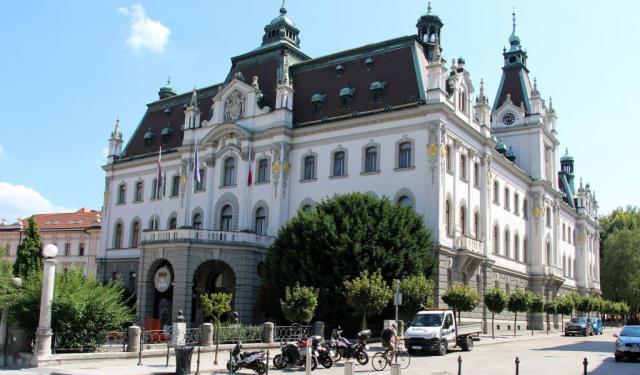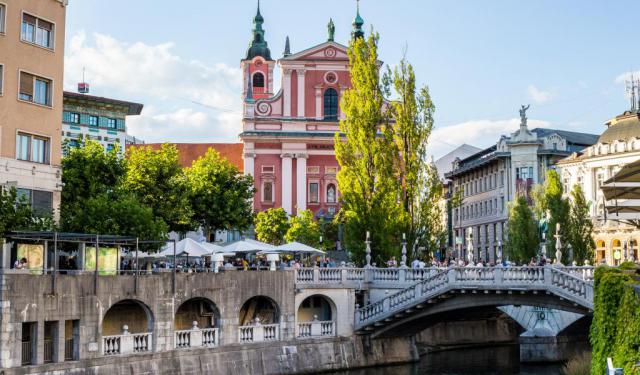
Slovenska filharmonija (Slovenian Philharmonic Building), Ljubljana
The roots of the Slovenian Philharmonic can be traced back to 1701 when the Academia Philharmonicorum was established as the first music society in Slovenia. Initially formed to commemorate Saint Cecilia's day and provide dignified funerals for its members, the Academia soon expanded its activities to include various performances at religious services and entertaining distinguished guests in Ljubljana. Through their performances, music gained significant appreciation among the Slovenian aristocracy.
In 1794, the Philharmonic Society succeeded the Academia, laying the foundation for the modern Slovenian Philharmonic; its membership included illustrious names such as Josef Haydn, Ludwig van Beethoven, Johannes Brahms, and Niccolò Paganini. Gustav Mahler, who began his conducting career here, was honored with a monument at the Court Square ("Dvorni trg") in 2011.
The current Slovenian Philharmonic building, designed by architect Adolf Wagner in the Neo-Renaissance style, opened its doors in 1891. Having endured two revolutions, two world wars, and the 1895 earthquake, the building stands as a "cultural monument of national importance" and serves as the home of the Slovenian Philharmonic Orchestra, renowned for its performances across the U.S. and Europe.
In 1794, the Philharmonic Society succeeded the Academia, laying the foundation for the modern Slovenian Philharmonic; its membership included illustrious names such as Josef Haydn, Ludwig van Beethoven, Johannes Brahms, and Niccolò Paganini. Gustav Mahler, who began his conducting career here, was honored with a monument at the Court Square ("Dvorni trg") in 2011.
The current Slovenian Philharmonic building, designed by architect Adolf Wagner in the Neo-Renaissance style, opened its doors in 1891. Having endured two revolutions, two world wars, and the 1895 earthquake, the building stands as a "cultural monument of national importance" and serves as the home of the Slovenian Philharmonic Orchestra, renowned for its performances across the U.S. and Europe.
Want to visit this sight? Check out these Self-Guided Walking Tours in Ljubljana. Alternatively, you can download the mobile app "GPSmyCity: Walks in 1K+ Cities" from Apple App Store or Google Play Store. The app turns your mobile device to a personal tour guide and it works offline, so no data plan is needed when traveling abroad.
Slovenska filharmonija (Slovenian Philharmonic Building) on Map
Sight Name: Slovenska filharmonija (Slovenian Philharmonic Building)
Sight Location: Ljubljana, Slovenia (See walking tours in Ljubljana)
Sight Type: Attraction/Landmark
Guide(s) Containing This Sight:
Sight Location: Ljubljana, Slovenia (See walking tours in Ljubljana)
Sight Type: Attraction/Landmark
Guide(s) Containing This Sight:
Walking Tours in Ljubljana, Slovenia
Create Your Own Walk in Ljubljana
Creating your own self-guided walk in Ljubljana is easy and fun. Choose the city attractions that you want to see and a walk route map will be created just for you. You can even set your hotel as the start point of the walk.
Historic Buildings Walking Tour
The Slovenian capital has no shortage of historical buildings. The architectural wealth of Ljubljana accumulated over the years received a significant boost in the early 20th century thanks to the famous Slovenian architect, Joze Plecnik, a classicist, who tried to model the city on ancient Athens.
Among the notable local landmarks is the Ljubljana Central Pharmacy, a testament to the... view more
Tour Duration: 2 Hour(s)
Travel Distance: 2.8 Km or 1.7 Miles
Among the notable local landmarks is the Ljubljana Central Pharmacy, a testament to the... view more
Tour Duration: 2 Hour(s)
Travel Distance: 2.8 Km or 1.7 Miles
Ljubljana Introduction Walking Tour
Ljubljana is the capital and the heart of Slovenia. Being the country's cultural and political center, it is also Slovenia's largest city and has a long, storied past.
The exact origin of its name is not clear. Some linguists suggest that it may be rooted in "Ljubija," the original name of the Ljubljanica River derived from the Old Slavic male name "Ljubovid,"... view more
Tour Duration: 2 Hour(s)
Travel Distance: 2.0 Km or 1.2 Miles
The exact origin of its name is not clear. Some linguists suggest that it may be rooted in "Ljubija," the original name of the Ljubljanica River derived from the Old Slavic male name "Ljubovid,"... view more
Tour Duration: 2 Hour(s)
Travel Distance: 2.0 Km or 1.2 Miles


